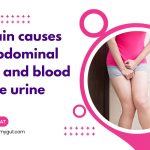Descending Colon Pain: 7 Causes, Gastroenterologist explains.
Our content is not intended nor recommended as a substitute for medical advice by your doctor. Use for informational purposes only.
The descending colon lies on the left side of your abdomen. Descending colon pain is often colicky. People with descending colon conditions often feel pain in the left side of the abdomen.
Possible causes of descending colon pain include:
- Constipation (including constipation-predominant IBS).
- Gas pain (colon distension).
- Irritable bowel syndrome (IBS).
- Food intolerance & allergy (including celiac disease).
- Diverticulitis
- Inflammatory bowel disease.
- Gastroenteritis (infectious colitis).
- Fecal impaction.
- Colorectal cancer.
- Other less
1. Constipation (Including Constipation-predominant IBS)
The stool travels in the colon in the following order: ascending colon, transverse colon, descending colon, Sigmoid colon, and then passes through the rectum during defecation.
The descending colon is one of the last stages in the journey of poop inside your gastrointestinal tract.
With constipation, stool often becomes stagnant in the last parts of your colon, namely the descending and sigmoid colon.
Constipation (particularly irritable bowel syndrome with constipation) frequently causes left-sided descending colon pain.
According to research, the left side (descending colon pain) is the most common location of constipation-related abdominal pain.
The accumulation of stool in the descending colon (on the left side) leads to over-stretching its walls. The stretch evokes left-sided abdominal pain (mainly in the left lower part).
The illustration below shows stool storage in the descending colon (with constipation). As a result, the stored stool becomes harder and bulky, stretching the walls of the descending colon (reference).
Chronic constipation is defined by the presence of any two of the following (reference):
- Passing hard lumpy stool.
- Less than three bowel movements per week.
- A sense of incomplete evacuation.
- Straining.
- Using your finger to help evacuate the bowel.
- A sense of rectal obstruction during bowel movements.
Any combination of two of the above symptoms is defined as chronic idiopathic constipation.
Chronic idiopathic constipation is different from constipation-predominant irritable bowel syndrome.
Abdominal pain is a pillar symptom in all IBS patients (100% of IBS sufferers experience abdominal pain). However, pain is not a fundamental symptom of chronic idiopathic constipation. About 11% only suffer from abdominal pain with chronic idiopathic (functional constipation) (reference).
This often explains the descending colon left-sided abdominal pain if you have chronic or occasional constipation.
The pain often goes away after constipation relief. Consult your doctor about the descending colon pain with constipation.
2. Gas pain.
Gas production is a physiological process inside your gastrointestinal tract. An average amount of gas doesn’t cause symptoms.
Gas inside your colon or intestine causes pain if:
- You over-swallow air (eating too fast or talking while eating).
- You eat excess gassy foods such as beans, fruits, green vegetables, and whole grains.
- You are sensitive (intolerant) to certain foods such as lactose, FODMAPs, etc. (see food intolerance below).
- Your colon is over-sensitive to NORMAL amounts of gas.
- Small intestinal bacterial overgrowth (SIBO).
Gas pain often causes generalized abdominal pain; however, localized descending colon pain on the left side can also occur.
Symptoms of gas pain include:
- Abdominal pain can be anywhere in your abdomen (diffuse) or localized in any area (including the descending colon area).
- Excessive burping.
- Bloating and distension.
- Sense of fullness after eating.
- Passing gas (farting).
3. Irritable bowel Syndrome.
Irritable bowel syndrome (with or without constipation) may cause left-sided descending colon pain.
Of course, the left side descending colon pain is more common with IBS-Constipation. However, The other types of IBS can also cause descending colon pain.
According to one study, about 13.1% of IBS sufferers experience pain exclusively on the left side (the side of descending colon pain).
7.1% of IBS sufferers feel pain in the left lower quadrant, and 6% experience left upper quadrant IBS pain (collectively, 13.1%).
The below figure illustrates the common IBS pain locations. Learn More Here.
The following characteristics are suggestive of IBS-related pain:
- First, the pain is recurrent at least one day per week for several months (at least 3-6 months).
- The pain is associated with defecation (it often improves after your defecation, but it can get worse).
- The pain is associated with changes in stool frequency and stool form (diarrhea or constipation).
- The pain is colicky.
- IBS pain is often associated with distension, mucus in stool, and sometimes anorexia.
Learn More about how we diagnose IBS.
4. Food intolerance.
Food intolerance is trouble digesting certain foods. The undigested food particles produce extra gases in your digestive tract causing symptoms.
Food allergy is an immune-mediated reaction to certain foods causing both intestinal and non-intestinal (extraintestinal) symptoms.
Food intolerances and allergies often cause diarrhea, abdominal bloating, and abdominal pain (left-sided at the descending colon location).
The differences and examples are illustrated in the below table.
| Food intolerance | Food allergy |
| Affects 15-20% of the population | Affects nearly 2-5% of adults |
| Difficulty digesting certain types of food (not immune-mediated allergy). | An immune-mediated reaction to certain foods or food components. |
| Causes “recurrent acute” or “chronic” attacks of diarrhea (which can be bright yellow & watery). | Usually causes acute attacks related to the ingestion of offending food. |
| Intestinal symptoms: diarrhea, extensive gas, bloating, and abdominal pain | Intestinal symptoms are the same |
| No extraintestinal symptoms | Extraintestinal symptoms like rashes, urticaria, swollen lips or face, or severe life-threatening allergic reactions. |
| The severity of your symptoms is proportional to the amount you eat from the offending food. | Even trace amounts of the offending food can produce severe symptoms. |
Common offending foods:
| Common offending foods: (examples)
|
5. Diverticulitis.
The colon diverticulum is a sac-like protrusion in the colon wall. It is a prevalent condition that increases with age.
When a diverticulum becomes inflamed, it is called Diverticulitis. Diverticulitis commonly affects the descending colon (reference).
Symptoms of Diverticulitis:
- Stabbing lower left abdominal pain. It is the most common symptom due to the involvement of the sigmoid and descending colon.
- The pain is usually constant, lasting for days with a gradual increase in intensity.
- Nausea and vomiting.
- Low-grade fever can also occur.
- A sense of tender mass in the lower left abdomen (in 20% of patients with acute Diverticulitis).
- Severe tenderness or gardening in the lower left abdomen.
- In severe cases (with access and perforation): low blood pressure and shock may be present.
- Change in bowel habits: constipation occurs in about 50% of patients with acute Diverticulitis, and diarrhea in 25-35% (reference).
6. Inflammatory bowel disease.
Inflammatory bowel disease is inflammation and ulcers affecting the gut tract. It has no apparent cause until now.
According to the CDC, about 1.3% of adults (around 3 million) reported being diagnosed with IBD (reference).
The inflammation and ulceration can be:
- Confined to the colon only; called Ulcerative Colitis.
- Affects any part of the gut tract (from mouth tooanus); this type is called Crohn’s disease.
- Microscopic colitis is another subtype of IBD, where inflammation is only seen by microscopic examination of a colon wall sample (not seen by colonoscopy).
The descending colon is one of the preferred sites of ulcerative colitis. Ulcerative colitis commonly causes left-sided descending colon pain.
Symptoms of IBD:
- Recurrent or persistent diarrhea.
- Mucus and/or blood in the stool.
- Frank rectal bleeding.
- Sharp abdominal pain: can occur at any site, including the location of the descending colon (left-sided abdominal pain).
- Generalized fatigue.
- Unexplained weight loss.
| Type | Crohn’s Disease | Ulcerative Colitis |
| 1- Site | Any part of the GI tract (from the mouth to theoanus) | The colon and rectum. |
| 2- Lesions | Deeper, it can involve all the layers of the GI wall. | Usually superficial (only in the innermost layer) |
| 3-Predominant symptom | Crampy abdominal pain | Bloody diarrhea. (can be constant) |
| 4- Complications | Fistulas, abscess, intestinal obstruction | hemorrhagic toxic megacolon. |
| 5- Risk of colon cancer | Slight increase | Marked increase |
7. Colorectal Cancer.
Colorectal cancer affecting the descending colon can cause left-sided abdominal pain. Colorectal cancer is among the most common cancers worldwide and in the USA.
Suspicious symptoms include:
- Recurrent diarrhea or constipation.
- Bloody or blackish stool.
- A sense of a mass inside your rectum.
- Unexplained prolonged fever or weight loss.
- Unexplained anemia.
Risk Factors for colorectal cancer:
- Being above 5o years old.
- Family history of colon cancer or polyps.
- Inflammatory bowel disease (IBD).
- Obesity.
- Alcoholism, smoking
- Eating lots of processed meat.
This article explains the symptoms of colorectal cancer in depth.
. Fecal impaction.
Fecal impaction occurs when a dry and hard stool mass obstructs the last part of the colon. The impacted mass is often located in the sigmoid or descending colon.
Fecal impaction is more common in elderly debilitated individuals. It commonly causes left lower abdominal pain.
Symptoms of stool impactions are:
- A persistent urge to poop, but nothing comes out.
- A sense of poop mass in the anorectum that is too big to come out.
- Abdominal pain increases after meals. The pain is often located on the left lower side (as fecal impaction primarily affects the descending and sigmoid parts of the colon).
- Sometimes, the liquid stool leaks around the impacted mass of feces.
- Poor appetite.
- Bloating or distension.
- Nausea, vomiting may also occur.
- Fatigue and headache.
. Infections (infectious colitis).
Infection of the gut tract (gastroenteritis) often causes diffuse or lower abdomen pain. However, it is less common to cause isolated left-sided abdominal pain (descending colon pain).
Bacterial, viral, or protozoal infections can cause gastroenteritis.
Symptoms include:
- Acute onset abdominal pain (often diffuse, but can be at the side of the descending colon pain to the left).
- Acute onset diarrhea.
- It may be excessive mucus or blood in the stool (dysentery).
- Nausea or vomiting.
- Fever may also present.
. Others (rare).
- Decreased blood supply to the colon (ischemic colitis).
- Hirschsprung disease.
- Intestinal obstruction.
- Adhesions.
When to see a doctor?
See a doctor for descending colon pain if:
- You have recurrent diarrhea (constipation attacks (prolonged for weeks).
- The onset of recurrent or chronic abdominal pain and your age is above 50.
- Extreme left-sided descending colon pain.
- Significant weight loss (more Than 20-25%of body weight within a few months).
- Blackish or Bloody stool.
- Unexplained fever for weeks or months.
- Unexplained anemia.
- Family history of colon cancer.
- Family or personal history of colon polyps or Familial Adenomatous polyposis.
- Evidence-based
- Written by a doctor.







